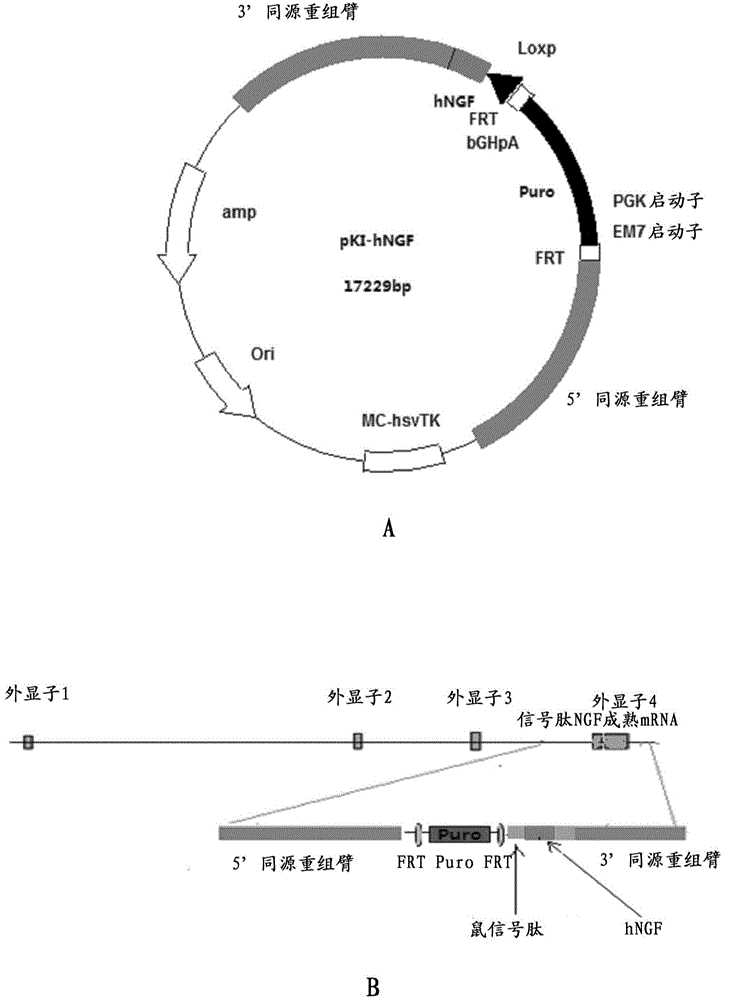Preparation method for transgenic mice capable of producing human nerve growth factor
A technology of nerve growth factor and transgenic mice, which is applied in the fields of molecular genetics and cell biology, can solve the problem of incorrect deletion of endogenous NGF gene in mice, achieve high success rate, simple operation, and overcome expression level unstable effect
- Summary
- Abstract
- Description
- Claims
- Application Information
AI Technical Summary
Problems solved by technology
Method used
Image
Examples
Embodiment 1
[0041] 1. Construction of homologous recombination template vector
[0042] The homologous recombination template vector was constructed based on the pBR322 plasmid, and its structure was as follows: figure 1 shown. The constructed vector contains 5'-homologous recombination arm, mouse NGF gene third intron sequence, FRT, puromycin resistance gene (Puro gene), FRT, mouse NGF signal peptide sequence, human NGF gene, Mouse NGF 3'-untranslated region sequence, 3'-homologous recombination arm. Through homologous recombination, the human NGF gene can be replaced in situ by the mouse NGF gene, and at the same time, a puromycin resistance gene is introduced upstream at the 5'-end, and there is an FRT site at each of its two ends, which can be passed through the FLP recombinase Effect, removal of the puromycin resistance gene. However, the upstream and downstream DNA sequences of mouse NGF did not change.
[0043] The sequence of the 5'-homologous recombination arm can be shown in...
Embodiment 2
[0092] Expression detection of human NGF in the submandibular gland of knock-in mice
[0093] 1) Human NGF gene knock-in homozygous mice and wild-type mice were sacrificed by neck dislocation, the submandibular glands were taken and frozen sections were 4-8 μm in size, left at room temperature for 30 minutes, fixed in acetone at 4°C for 10 minutes, washed with PBS, 5 minutes × 3 times. Incubate with 3% hydrogen peroxide for 5-10 minutes to eliminate the activity of endogenous peroxidase. Wash with PBS, 5 minutes x 2 times.
[0094] 2) Block with 5-10% normal goat serum (diluted in PBS), and incubate at room temperature for 10 minutes. Pour off the serum, do not wash, add rabbit anti-human NGF antibody diluted in an appropriate proportion dropwise, and incubate at 37°C for 1-2 hours or overnight at 4°C. Rinse with PBS, 5 minutes x 3 times.
[0095] 3) Add fluorescein-labeled goat anti-rabbit secondary antibody (diluted in 1% BSA-PBS) in an appropriate proportion dropwise, i...
Embodiment 3
[0097] Embodiment 3: the acquisition and purification of NGF
[0098] 1. The mouse submandibular glands stored at -20°C were thawed in 0.5mM EDTA solution and homogenized (2ml / g tissue), then centrifuged at 9000 rpm at 4°C for 30 minutes, and the supernatant was taken and freeze-dried. The sample was redissolved with 4 ml of 50 mM PBS solution (pH 6.8), and dialyzed against the same buffer for 72 hours. The medium was changed 3 times in the middle. Then the CM-52 ion exchange resin (25 * 40 centimeters) that dialysate is balanced on the sample after dialysis, collects the effluent of OD. Then dialyze with 20 times the volume of 25mM PBS solution (pH6.8) for 72 hours, and change the solution three times.
[0099] 2. Replace the dialysate with 50mM sodium acetate / sodium chloride buffer (pH4.0), continue dialysis for 72 hours, and collect the supernatant after centrifugation.
[0100] 3. The CM-52 resin column (5×25cm) equilibrated with 50mM sodium acetate / sodium chloride buff...
PUM
 Login to View More
Login to View More Abstract
Description
Claims
Application Information
 Login to View More
Login to View More - R&D
- Intellectual Property
- Life Sciences
- Materials
- Tech Scout
- Unparalleled Data Quality
- Higher Quality Content
- 60% Fewer Hallucinations
Browse by: Latest US Patents, China's latest patents, Technical Efficacy Thesaurus, Application Domain, Technology Topic, Popular Technical Reports.
© 2025 PatSnap. All rights reserved.Legal|Privacy policy|Modern Slavery Act Transparency Statement|Sitemap|About US| Contact US: help@patsnap.com



